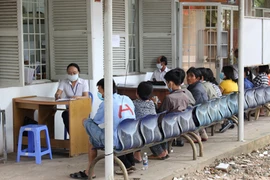HCM City (VNA) - An estimated 5,500people living with HIV in the community have yet to be identified in Ho ChiMinh City, with about 30 percent having high viral load rates that arepotentially transmitting the virus to others, according to Deputy Director of themunicipal Department of Health Nguyen Huu Hung.
Addressing a conference to review the HIV/AIDS prevention over the last 30years in Ho Chi Minh City on January 14, Hung stressed that this is one of thechallenges in the fight against HIV/AIDS at present.
Since the first case of HIV infection found in HCM City in December 1990, themunicipal authorities have focused on curbing the epidemic's development viacommunications and education activities to raise public awareness of protectingthemselves, and building HIV prevention models.
As a result, the rate of HIV infection among drug users decreasedto 18.6 percent 1998 from 42.3 percent in 1995.
In the 2000-2010 period, HIV prevention models were applied across the city.Meanwhile, the introduction of antiretroviral (ARV) therapy created favourableconditions for the city to expand prevention and treatment programmes.
The city has so far had 145 facilities providing HIV consultation and testingservices and 24 providing methadone treatment, which have treated about 5,400patients.
In addition, the community re-integration support programme and those toprevent mother-to-child HIV transmission havebeen effectively implemented, significantly contributing to reducing thenumber of new infections in the community.
In the last decade, the municipal authorities have promoted the supply of Pre-Exposure Prophylaxis (PrEP) service and ARVdrugs, creating breakthroughs in controlling HIV infection.
It has realised the 90-90-90 target setby the UN, which means 90 percent of people living with HIV know their status,90 percent of those diagnosed are provided with antiretroviral therapy, and 90 percent of those treated with antiretroviraltherapy achieve viral suppression.
However, Hung mentioned a fact that a strong increase in the number of men whohave sex with men (MSM) has been pushing up the risk of infection in thecommunity.
Towards ending AIDS by 2030, the city will pay attention to promotingpreventive and testing services, and investigations.
It set to fulfill the 95-95-95 target by 2025, and the 99-99-99 target to endthe epidemic by 2030, Hung said./.






























